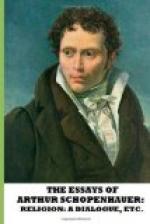When Socrates said to a young man who was introduced to him to have his capabilities tested, “Talk in order that I may see you,” if indeed by “seeing” he did not simply mean “hearing,” he was right, so far as it is only in conversation that the features and especially the eyes become animated, and the intellectual resources and capacities set their mark upon the countenance. This puts us in a position to form a provisional notion of the degree and capacity of intelligence; which was in that case Socrates’ aim. But in this connection it is to be observed, firstly, that the rule does not apply to moral qualities, which lie deeper, and in the second place, that what from an objective point of view we gain by the clearer development of the countenance in conversation, we lose from a subjective standpoint on account of the personal relation into which the speaker at once enters in regard to us, and which produces a slight fascination, so that, as explained above, we are not left impartial observers. Consequently from the last point of view we might say with greater accuracy, “Do not speak in order that I may see you.”
For to get a pure and fundamental conception of a man’s physiognomy, we must observe him when he is alone and left to himself. Society of any kind and conversation throw a reflection upon him which is not his own, generally to his advantage; as he is thereby placed in a state of action and reaction which sets him off. But alone and left to himself, plunged in the depths of his own thoughts and sensations, he is wholly himself, and a penetrating eye for physiognomy can at one glance take a general view of his entire character. For his face, looked at by and in itself, expresses the keynote of all his thoughts and endeavors, the arret irrevocable, the irrevocable decree of his destiny, the consciousness of which only comes to him when he is alone.
The study of physiognomy is one of the chief means of a knowledge of mankind, because the cast of a man’s face is the only sphere in which his arts of dissimulation are of no avail, since these arts extended only to that play of feature which is akin to mimicry. And that is why I recommend such a study to be undertaken when the subject of it is alone and given up to his own thoughts, and before he is spoken to: and this partly for the reason that it is only in such a condition that inspection of the physiognomy pure and simple is possible, because conversation at once lets in a pathognomical element, in which a man can apply the arts of dissimulation which he has learned: partly again because personal contact, even of the very slightest kind, gives a certain bias and so corrupts the judgment of the observer.




